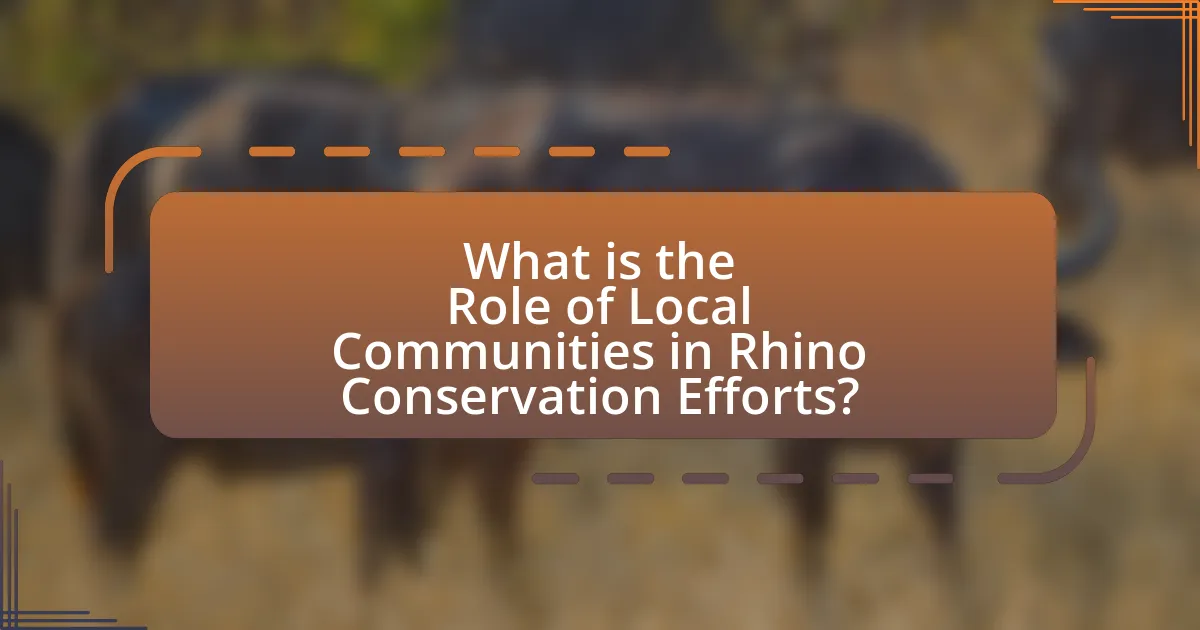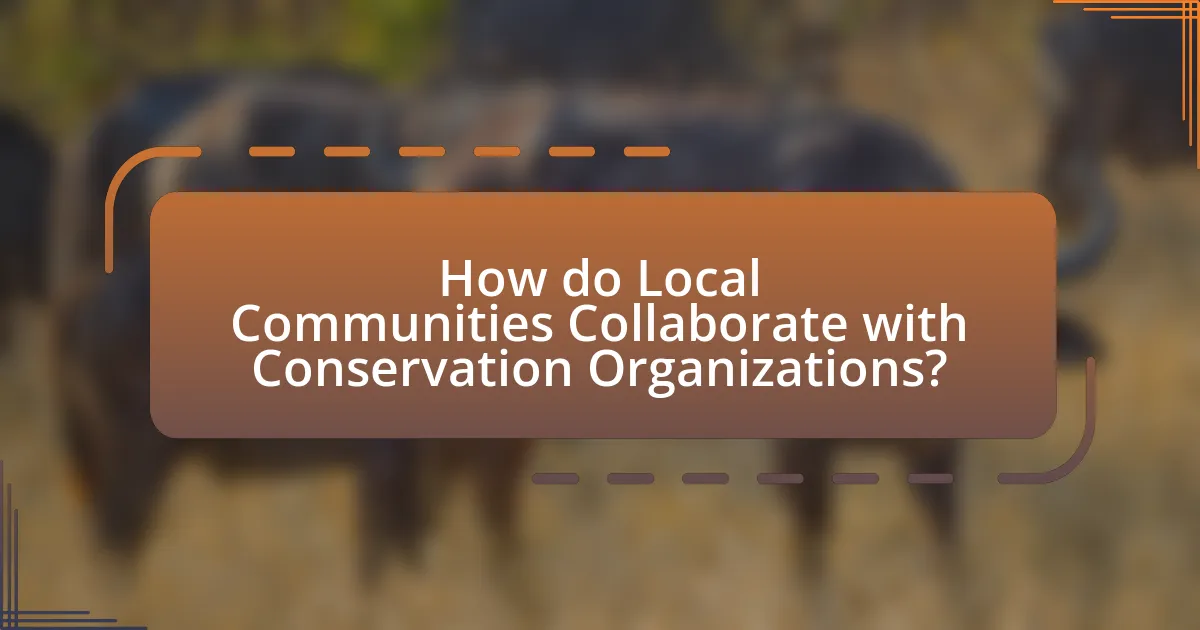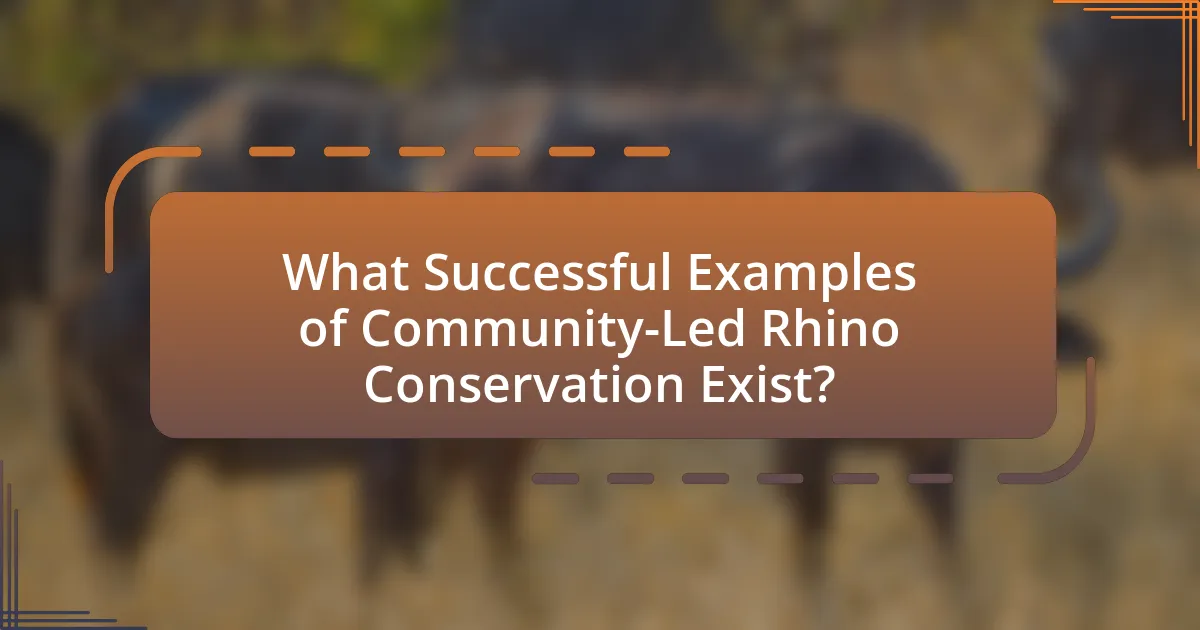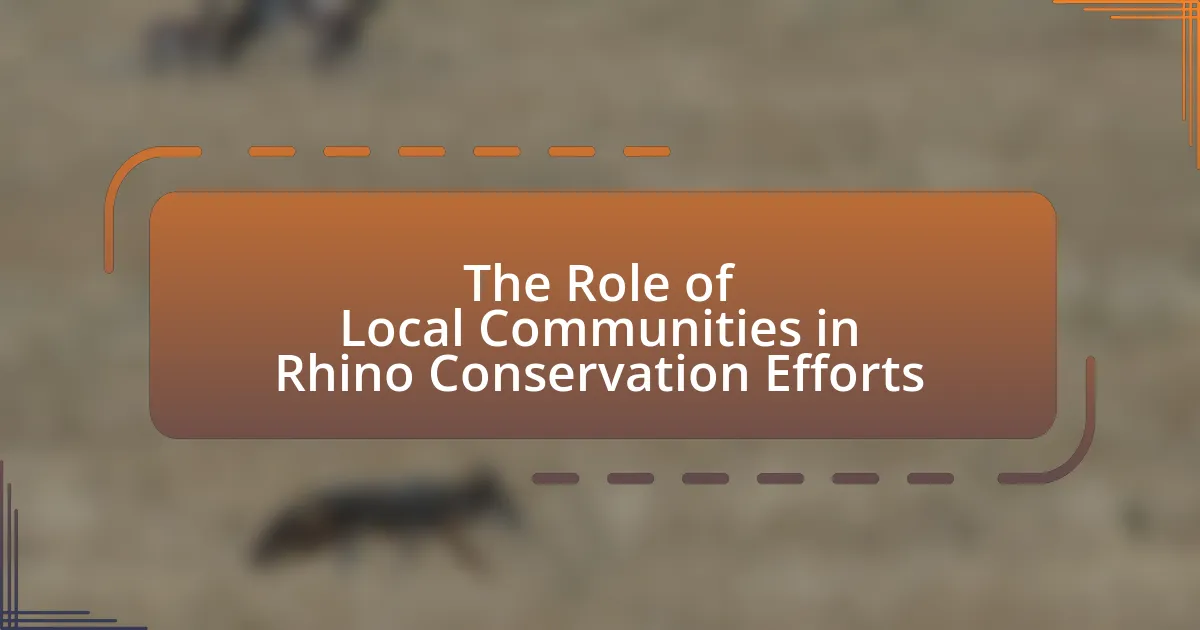Local communities are integral to rhino conservation efforts, actively participating in protection initiatives and sustainable practices that significantly impact rhino populations. Their contributions include monitoring rhino populations, engaging in anti-poaching activities, and participating in habitat restoration projects, often leading to substantial reductions in poaching rates. Community-based conservation programs, particularly in regions like South Africa and Namibia, demonstrate that when local people benefit economically from wildlife tourism, they are more likely to protect rhinos. The article explores the specific actions taken by local communities, their collaboration with conservation organizations, the socio-economic factors influencing participation, and successful case studies that highlight the effectiveness of community-led initiatives in enhancing rhino conservation outcomes.

What is the Role of Local Communities in Rhino Conservation Efforts?
Local communities play a crucial role in rhino conservation efforts by actively participating in protection initiatives and sustainable practices. Their involvement often includes monitoring rhino populations, reporting poaching activities, and engaging in habitat restoration projects. For instance, community-based conservation programs in countries like South Africa have demonstrated that when local people benefit economically from wildlife tourism, they are more likely to protect rhinos. A study by the World Wildlife Fund indicates that community-led initiatives can reduce poaching rates by up to 50% when local stakeholders are invested in conservation outcomes. This evidence underscores the importance of integrating local communities into conservation strategies to enhance the effectiveness of rhino protection efforts.
How do local communities contribute to rhino conservation?
Local communities contribute to rhino conservation by actively participating in anti-poaching efforts and habitat protection. These communities often serve as the first line of defense against poaching, utilizing local knowledge to monitor and report suspicious activities. For instance, community-based conservation programs in countries like South Africa have shown that when local people are involved, poaching rates can decrease significantly; in some areas, poaching has dropped by over 80% due to community engagement. Additionally, local communities benefit economically from conservation through eco-tourism initiatives, which incentivize them to protect rhinos and their habitats. This dual approach of direct involvement and economic benefit creates a sustainable model for rhino conservation.
What specific actions do local communities take in conservation efforts?
Local communities engage in various specific actions for conservation efforts, including habitat protection, anti-poaching initiatives, and community-based tourism. Habitat protection involves local groups managing and restoring ecosystems critical for rhino survival, such as grasslands and forests. Anti-poaching initiatives are often spearheaded by community members who participate in patrols and surveillance to deter illegal hunting. Community-based tourism allows locals to benefit economically from wildlife conservation, incentivizing them to protect rhinos and their habitats. These actions are supported by studies showing that community involvement leads to more effective conservation outcomes, as seen in regions like Namibia, where local management has resulted in increased rhino populations.
How do local communities engage with conservation organizations?
Local communities engage with conservation organizations through collaborative projects, education initiatives, and participatory management practices. These partnerships often involve local stakeholders in decision-making processes, ensuring that their knowledge and needs are integrated into conservation strategies. For instance, in various regions, community-led patrols have been established to combat poaching, demonstrating effective local involvement in wildlife protection. Research indicates that when communities are actively involved, such as in the case of the African Rhino Conservation Program, there is a significant increase in conservation success rates, highlighting the importance of local engagement in achieving sustainable outcomes.
Why is community involvement crucial for rhino conservation?
Community involvement is crucial for rhino conservation because it fosters local stewardship and sustainable practices that directly impact rhino populations. Engaging communities in conservation efforts leads to increased awareness and education about the importance of rhinos, which can reduce poaching and habitat destruction. For instance, studies have shown that areas with strong community engagement in conservation initiatives experience lower rates of poaching; a report by the International Union for Conservation of Nature indicates that community-managed areas can reduce poaching incidents by up to 50%. Furthermore, when local communities benefit economically from conservation, such as through eco-tourism, they are more likely to protect rhinos and their habitats.
What are the benefits of local community participation in conservation?
Local community participation in conservation enhances biodiversity protection and promotes sustainable resource management. Engaging local communities fosters a sense of ownership and responsibility towards conservation efforts, leading to more effective protection of ecosystems. Studies have shown that areas with active community involvement, such as the community-based conservation initiatives in Namibia, have seen significant increases in wildlife populations, including rhinos. Furthermore, local participation often results in improved economic benefits for communities through eco-tourism and sustainable practices, which can provide financial incentives to protect natural resources.
How does community involvement impact rhino populations?
Community involvement significantly enhances rhino populations by fostering local stewardship and reducing poaching. When communities actively participate in conservation efforts, they develop a vested interest in protecting rhinos, leading to increased monitoring and reporting of illegal activities. For instance, programs like community-based natural resource management in Namibia have shown that local communities can effectively manage wildlife resources, resulting in a 50% increase in rhino populations from 1995 to 2015. Additionally, financial incentives from eco-tourism initiatives empower communities economically, further motivating them to safeguard rhinos. Thus, community engagement is crucial for the sustainability and growth of rhino populations.
What challenges do local communities face in conservation efforts?
Local communities face significant challenges in conservation efforts, primarily due to economic pressures, lack of resources, and insufficient support from governmental and non-governmental organizations. Economic pressures often lead communities to prioritize immediate financial needs over long-term conservation goals, resulting in habitat destruction and poaching. Additionally, many local communities lack the necessary resources, such as funding and training, to effectively engage in conservation practices. A study by the World Wildlife Fund highlights that without adequate support, local initiatives struggle to implement sustainable practices, which undermines conservation efforts. Furthermore, the disconnect between conservation policies and local needs can lead to resistance from communities, as they may feel excluded from decision-making processes that directly affect their livelihoods.
What socio-economic factors affect community participation?
Socio-economic factors that affect community participation include income levels, education, employment opportunities, and social cohesion. Higher income levels often correlate with increased community engagement, as individuals with financial stability are more likely to invest time and resources into local initiatives. Education plays a crucial role, as communities with higher educational attainment tend to have better awareness of conservation issues and are more likely to participate in related activities. Employment opportunities, particularly in conservation-related fields, can incentivize community involvement by providing both financial and social benefits. Additionally, strong social cohesion within a community fosters collaboration and collective action, enhancing participation in conservation efforts. Studies have shown that communities with these socio-economic advantages are more effective in engaging in conservation initiatives, thereby positively impacting local wildlife, including rhinos.
How do conflicts with wildlife impact local communities’ conservation efforts?
Conflicts with wildlife significantly undermine local communities’ conservation efforts by creating economic and social challenges. When wildlife, such as rhinos, encroaches on agricultural land or threatens livestock, it leads to financial losses for farmers, which can foster resentment towards conservation initiatives. For instance, a study by the World Wildlife Fund found that in regions where human-wildlife conflicts are prevalent, local support for conservation drops by up to 50%, as communities prioritize immediate economic survival over long-term ecological benefits. This decline in support can result in reduced funding and resources for conservation programs, ultimately jeopardizing the survival of endangered species like rhinos.

How do Local Communities Collaborate with Conservation Organizations?
Local communities collaborate with conservation organizations through partnerships that involve shared goals, resource management, and community engagement. These collaborations often include joint initiatives such as anti-poaching patrols, habitat restoration projects, and educational programs aimed at raising awareness about rhino conservation. For instance, the African Wildlife Foundation has successfully partnered with local communities in Kenya, resulting in a 50% reduction in poaching incidents in areas where community rangers are actively involved. This demonstrates that when local communities are empowered and included in conservation efforts, they can significantly contribute to the protection of endangered species like rhinos.
What partnerships exist between local communities and conservation groups?
Partnerships between local communities and conservation groups often include collaborative initiatives aimed at protecting rhino populations and their habitats. These partnerships typically involve community-based conservation programs where local residents participate in wildlife monitoring, anti-poaching efforts, and habitat restoration projects. For instance, the African Wildlife Foundation collaborates with local communities in Kenya to implement conservation strategies that benefit both wildlife and local livelihoods. Such partnerships have been shown to enhance conservation outcomes by fostering a sense of ownership and responsibility among community members, leading to increased support for conservation efforts.
How do these partnerships enhance conservation strategies?
Partnerships enhance conservation strategies by integrating local community knowledge and resources into rhino conservation efforts. These collaborations leverage the expertise of local populations, who possess a deep understanding of the ecosystem and the challenges faced by rhinos. For instance, studies have shown that community-led initiatives can reduce poaching rates significantly; in Namibia, community conservancies have led to a 90% reduction in poaching incidents since their implementation. Additionally, partnerships foster economic incentives for local communities, encouraging them to protect rhinos rather than exploit them. This dual approach not only strengthens conservation outcomes but also promotes sustainable development within the communities involved.
What roles do NGOs play in supporting local communities?
NGOs play a crucial role in supporting local communities by providing resources, education, and advocacy that empower these communities to engage in conservation efforts. They facilitate training programs that enhance local skills in sustainable practices, which directly contribute to the preservation of rhino habitats. For instance, organizations like the World Wildlife Fund have implemented community-based conservation initiatives that not only protect wildlife but also improve local livelihoods through eco-tourism and sustainable agriculture. This dual focus on conservation and community development demonstrates the effectiveness of NGOs in fostering a collaborative approach to environmental stewardship.
How can local communities be empowered in conservation initiatives?
Local communities can be empowered in conservation initiatives by involving them in decision-making processes and providing them with the necessary resources and training. Empowerment fosters a sense of ownership and responsibility towards conservation efforts, which is crucial for the sustainability of initiatives. For instance, programs that include local residents in wildlife management and monitoring have shown increased success rates, as seen in the case of community-based conservation in Namibia, where local involvement led to a significant increase in rhino populations. Additionally, financial incentives, such as eco-tourism revenue sharing, can motivate communities to actively participate in conservation, further reinforcing their role in protecting endangered species like rhinos.
What training and resources are necessary for effective community involvement?
Effective community involvement in rhino conservation requires training in ecological awareness, community organizing, and conflict resolution, along with resources such as educational materials, funding for local initiatives, and access to conservation experts. Training programs should focus on the importance of biodiversity, the role of rhinos in ecosystems, and strategies for sustainable practices. Resources like workshops, informational brochures, and online platforms can enhance knowledge and engagement. For instance, the World Wildlife Fund has successfully implemented community training programs that have led to increased local participation in conservation efforts, demonstrating the effectiveness of structured training and resource allocation in fostering community involvement.
How can local knowledge be integrated into conservation practices?
Local knowledge can be integrated into conservation practices by actively involving local communities in decision-making processes and utilizing their understanding of the ecosystem. This approach recognizes that local communities possess valuable insights about wildlife behavior, habitat conditions, and sustainable resource management, which can enhance conservation strategies. For instance, studies have shown that community-based conservation initiatives, such as those in Namibia, have successfully reduced poaching rates by incorporating local knowledge into anti-poaching efforts and habitat management. By fostering collaboration between conservationists and local populations, conservation practices can be more effective and culturally relevant, leading to better outcomes for both wildlife and communities.

What Successful Examples of Community-Led Rhino Conservation Exist?
Successful examples of community-led rhino conservation include the Black Rhino Range Expansion Project in South Africa and the community conservancies in Namibia. The Black Rhino Range Expansion Project, initiated in 2003, has successfully increased the black rhino population from 1,800 to over 5,000 individuals by involving local communities in conservation efforts and land management. In Namibia, community conservancies have empowered local people to manage wildlife resources, leading to a significant increase in rhino populations, with over 1,800 black and white rhinos recorded in communal areas by 2020. These initiatives demonstrate the effectiveness of engaging local communities in conservation, resulting in both ecological and economic benefits.
What case studies highlight effective community involvement in rhino conservation?
Case studies that highlight effective community involvement in rhino conservation include the Ol Pejeta Conservancy in Kenya and the Community Wildlife Conservancies in Namibia. At Ol Pejeta, local communities participate in anti-poaching efforts and benefit from eco-tourism revenues, which have led to increased support for rhino protection. In Namibia, community conservancies empower locals to manage wildlife resources, resulting in a significant increase in black rhino populations from 2,400 in 1995 to over 5,000 in 2020. These examples demonstrate that engaging local communities not only enhances conservation outcomes but also fosters economic benefits for those directly involved.
What lessons can be learned from these successful initiatives?
Successful initiatives in rhino conservation demonstrate the importance of community involvement, sustainable practices, and education. Engaging local communities fosters a sense of ownership and responsibility towards wildlife, leading to increased protection efforts. For instance, programs that integrate local livelihoods with conservation, such as eco-tourism, have shown to reduce poaching rates significantly. A study by the World Wildlife Fund indicated that areas with community-led conservation initiatives experienced a 50% decrease in rhino poaching over five years. This evidence underscores the effectiveness of collaborative approaches that align conservation goals with community benefits.
How have these examples influenced broader conservation policies?
Local community involvement in rhino conservation has significantly influenced broader conservation policies by demonstrating the effectiveness of grassroots engagement in biodiversity protection. For instance, successful community-led initiatives in countries like South Africa and Namibia have led to the integration of local stakeholders in decision-making processes, resulting in policies that prioritize sustainable land use and wildlife management. These examples have prompted governments and international organizations to adopt similar frameworks, emphasizing community rights and benefits-sharing as essential components of conservation strategies. The recognition of local knowledge and practices has been formalized in policies such as the Convention on Biological Diversity, which encourages participatory approaches in conservation efforts globally.
What best practices can be adopted from successful community conservation efforts?
Successful community conservation efforts can adopt best practices such as inclusive stakeholder engagement, sustainable resource management, and education and awareness programs. Inclusive stakeholder engagement ensures that local communities are actively involved in decision-making processes, which fosters a sense of ownership and responsibility towards conservation. For instance, the African Wildlife Foundation emphasizes that involving local populations in wildlife management leads to better outcomes, as seen in community-based conservation projects in Namibia, where local communities have successfully reduced poaching rates.
Sustainable resource management practices, such as eco-tourism and community-managed reserves, provide economic incentives for conservation while ensuring the protection of wildlife habitats. A study by the World Resources Institute highlights that eco-tourism initiatives in Kenya have generated significant revenue for local communities, which in turn supports conservation efforts.
Education and awareness programs are crucial for fostering a conservation ethic among community members. Research published in the Journal of Environmental Management indicates that educational initiatives in rural areas of South Africa have increased local support for rhino conservation by raising awareness about the ecological and economic benefits of preserving wildlife.
These best practices demonstrate that successful community conservation efforts rely on collaboration, sustainable practices, and education to achieve long-term conservation goals.
How can these practices be implemented in other regions?
Local communities can implement rhino conservation practices in other regions by establishing community-based conservation programs that engage local stakeholders. These programs can include education initiatives to raise awareness about the importance of rhinos and their ecosystems, as demonstrated by successful models in South Africa, where community involvement has led to increased protection of rhino populations. Additionally, creating economic incentives, such as eco-tourism opportunities, can motivate communities to participate actively in conservation efforts, as seen in Namibia, where local communities benefit financially from wildlife conservation. These strategies have proven effective in fostering a sense of ownership and responsibility towards wildlife, thereby enhancing conservation outcomes in various regions.
What role does education play in promoting successful conservation practices?
Education plays a crucial role in promoting successful conservation practices by equipping individuals and communities with the knowledge and skills necessary to understand and engage in conservation efforts. Through educational programs, local communities learn about the ecological importance of species like rhinos, the threats they face, and the benefits of biodiversity, which fosters a sense of responsibility and stewardship. For instance, studies have shown that communities involved in educational initiatives are more likely to participate in conservation activities, as evidenced by the success of programs in South Africa where local schools incorporate wildlife conservation into their curricula, leading to increased community engagement and support for rhino protection efforts.
